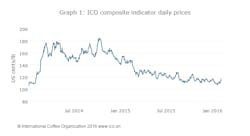ICO: Robusta Prices Fall To Five And A Half Year Low
The coffee market dropped to a two-year low in January, primarily driven by falling Robusta prices, the International Coffee Organization (ICO) reported. Exports for the first quarter of coffee year 2015/16 were 2.6% higher than last year on 26.9 million bags, with minimal supply concerns at this time. Conab have released their first estimate of coffee production in Brazil for the upcoming crop year 2016/17, which is provisionally expected to recover to the record volumes of 2012/13 and 2013/14, following two years of lower output. This may also be putting downward pressure on prices.
Coffee prices fell further in January, with the monthly average of the ICO composite indicator down by 3.3% to 110.89 cents, its lowest level since January 2014. The daily price dropped to a minimum of 106.74 cents on the 20th January, which is the lowest daily level since the 2nd January 2014. This dip coincided with a broader rout in commodity prices, led by the collapse in oil prices. Coffee prices recovered slightly towards the end of the month, but remain at very low levels.
This decline in the market was most pronounced in the Robusta group, which fell by 5.8% to 74.71 cents, its lowest monthly level since May 2010. This has been attributed to higher supply anticipated from Vietnam, with the new crop shortly to come to market and significant carryover stocks expected from last year’s crop. The three Arabica groups also fell, with Colombian Milds, Other Milds and Brazilian Naturals down by 3.3%, 2.4% and 2% respectively, with the supply outlook also looking positive.
Total exports in December 2015 came to 9.3 million bags, 1.3% more than December 2014. This brings exports for the first quarter of coffee year 2015/16 (October to December) to 26.9 million bags, up 2.6% compared to the same period last year. Shipments of Arabica coffee were up by 11% to 17.6 million, with the biggest increase found in Colombian Milds, as Colombia shipped 3.5 million bags of coffee, its highest volume for the quarter since 2001/02. Other Milds were also up by 11.7% and Brazilian Naturals by 9.6%.
Exports of Robusta, on the other hand, are estimated lower by 10.1% compared to last year, with exports from the two largest origins, Vietnam and Indonesia, estimated down by 11% and 23.4% respectively. However, exports from Vietnam have started to pick up, with the 2 million bags estimated in December the highest monthly volume since March 2015.
In terms of production, the Brazilian coffee authorities Conab have released their first forecast of coffee production for crop year 2016/17, which starts in April. According to this initial estimate, output could recover strongly from 43.2 million bags in 2015/16 to between 49.1 million and 51.9 million bags. The upper end of this range would represent a record crop for Brazil, higher than the 50.8 million produced in 2012/13. Arabica production is provisionally up by between 17.8% and 24.4%, which has been attributed to favourable climatic conditions, and the fact that 2016/17 is an on-year in Brazil’s biennial production cycle. Robusta is up more modestly by between 1.8% and 8%, which would still be lower than the level in 2012/13.
Finally, world consumption in calendar year 2014 has been revised up slightly to 150.2 million bags, as domestic consumption in some exporting countries, particularly those in Asia, was adjusted higher.
